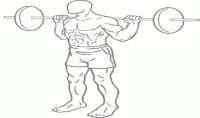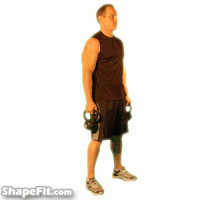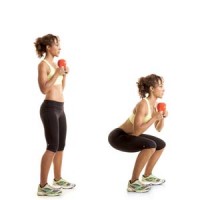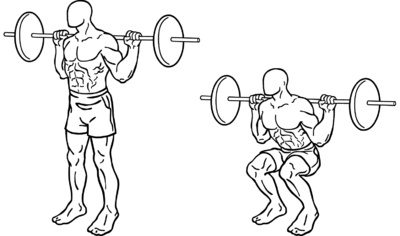If you read our recent article on why a kettlebell is the only piece of home gym equipment you need to get in great shape then you will know we are big fans of this heavyweight Russian export. If you took our advice and picked up one of these pieces of home gym equipment then the chances are you are very happy with your purchase but you might still have a few questions when it comes to using them and a question we often hear asked is ‘how can I do a good lower body workout with just a kettlebell?’.
Well this question is easier to answer than you might think as these weights are very versatile and once you start using your imagination you can find literally hundreds of exercises to perform to help you build muscle, burn fat and ‘tone up’.
These kettlebell exercises are equally suitable for men and women and if your goals are to add lean muscle mass, get that toned and athletic look and burn off those excess calories then these exercises are for you. If you are a female trainer and aren’t sure if kettlebell training is for you then check out this article on the suitability of kettlebells for women trainers.
The Best Lower Body Kettlebell Exercises
 The most effective and probably the best known lower body exercise is the squat. This exercise primarily works the thigh, hip and buttock muscles as well as a whole host of secondary muscles such as the lower back, upper arms and the shoulders not to mention the abdominal muscles found around your stomach which you need to develop if you want to complete the beach body look with a six pack. If there was one exercise that could be termed as vital for those who want to get in great shape then it would probably be the squat.
The most effective and probably the best known lower body exercise is the squat. This exercise primarily works the thigh, hip and buttock muscles as well as a whole host of secondary muscles such as the lower back, upper arms and the shoulders not to mention the abdominal muscles found around your stomach which you need to develop if you want to complete the beach body look with a six pack. If there was one exercise that could be termed as vital for those who want to get in great shape then it would probably be the squat.
Despite all this lots of people avoid this exercise as it looks quite difficult to perform and has a hint of potential danger about it. While those observations are not entirely incorrect, when executed correctly the squat is very safe and not quite as difficult to master as first appearances may suggest.
When most people picture the squat exercise, they usually imagine people in squat racks with a well loaded barbell on their shoulders squatting for all their worth. While this is usually the case there are other ways to do this exercise that don’t require the use of a lot of equipment and one such variation on this exercise is the kettlebell squat.
How to Perform Kettlebell Squats
 If you are lucky enough to have two kettlebells then you can do this exercise by holding a weight in each hand and letting your arms hang down by your sides. Don’t worry if you only have one kettlebell as you can perform the one weight variation of this exercise by following the second set of instructions below. The variation on the squat that requires two weights is sometimes referred to as the suitcase squat as you hold the weights as if you were holding a heavy suitcase in each hand. If you have two weights hold one in each of your hands by the handles with your palms facing inwards towards your body and the bells hanging down. Perform this great leg exercise like so:
If you are lucky enough to have two kettlebells then you can do this exercise by holding a weight in each hand and letting your arms hang down by your sides. Don’t worry if you only have one kettlebell as you can perform the one weight variation of this exercise by following the second set of instructions below. The variation on the squat that requires two weights is sometimes referred to as the suitcase squat as you hold the weights as if you were holding a heavy suitcase in each hand. If you have two weights hold one in each of your hands by the handles with your palms facing inwards towards your body and the bells hanging down. Perform this great leg exercise like so:
- Start in a standing position with a kettlebell in each hand and your palms facing your body.
- Keeping your back straight bend your legs at the knees at the same time as bending your hips as if you are going to sit down on an imaginary chair.
- As you lower yourself make sure your knees don’t move over or past your toes – you do not want to bend over forwards but want to lean back as if getting into more of a sitting position.
- When your thighs are parallel with the ground you have reached the point where many people consider the exercise to be completed. Some people go deeper to perform a more strenuous workout but you can stop here if you chose. Do not stop before your thighs are parallel with the ground as you will not have gone deep enough.
- Return to the starting position by pushing upwards from your feet and through your legs. Do not slide your knees forward as this will take the weight off your legs and the hamstrings which you are trying to work with this exercise.
To avoid injury make sure you observe the following:
- Do not descend too quickly. Move in a slow, controlled motion staying in control of your movement the whole time.
- Do not extend your torso too far forward; try to keep it relatively upright with your back in a straight line from waist to neck. Failure to prevent your torso from extending forward can put too much pressure on your lower back which could cause an injury.
- Keep your knees behind your toes. Do not bend your legs with your knees moving beyond your toes. If you looked down straight through your knees your toes should be in front of them.
If you are unsure of how to perform kettlebell squats ask an experienced trainer or consult a personal trainer at your local gym. To practice this exercise try performing it without any weights and position a chair behind you so you can practice siting down and standing up without using your arms. You can use a chair while you do the exercise for real and these are called box squats – just make sure the chair is strong enough to hold your weight and the weights you are using!
Squats with One Kettlebell
 If you just have one kettlebell then we do not recommend you try and do the above exercise with just one weight. Performing this exercise and being off balance is a good way to get injured and there is no need to even attempt it as this version works just as well:
If you just have one kettlebell then we do not recommend you try and do the above exercise with just one weight. Performing this exercise and being off balance is a good way to get injured and there is no need to even attempt it as this version works just as well:
- In an upright standing position hold the handle of one kettlebell with both hands with the weight in front of you close to your chest.
- Position your feet slightly less than shoulder with apart and do not lock your knees.
- Squat down by bending your knees but keeping your back straight.
- As you get closer to the ground make sure that your back is still in the upright position and your knees do not move over or in front of your toes.
- Imagine you are sitting back onto a chair rather than bending forward to pick something up.
- When your upper legs from your knees to your waist are parallel with the ground you have reached the end of the exercise. You can of course go lower but parallel with the ground is good enough for starting out.
- Pause for a second then push up from your legs to return to the starting position.
Do these exercises for three sets of eight to 12 repetitions. Do not fall for the toning myth that states you need to do lots of repetitions with a light weight to ‘get toned’. This is rubbish and if you want to improve your muscle tone you will need to perform between eight and 12 reps with a heavy weight. If you are using one kettlebell and your strength improves to the point where the weight is too light and you can easily do 12 reps then you can try either using two kettlebells with one in each hand or going down further at the end of the squat. Once you have exhausted both these options then you might need to upgrade to a heavier set of weights or invest in a set of adjustable kettlebells which allow you to add more weights to the bell without replacing the whole thing as your strength improves.
Other Kettlebell Leg Exercises
The above mentioned kettlebell squat variations are ideal for a full lower body workout as they hit multiple muscle groups in the bottom half of your body as well as your core. There are other kettlebell leg exercises you can add to your repertoire to keep your workouts dynamic and varied and also to prevent you losing interest but the squat should be a the core of any workout whether training at home or the gym.
Whatever type of kettlebell sets you have access to, I hope you can now see that its possible to work almost any muscle group with this piece of fitness equipment and start working towards your goals with as little fuss as possible.
Some other leg exercises you can perform at home with a kettlebell include:
- One legged kettlebell squats
- Kettlebell lunges
- Box squats
- Double swings
- Calf Raises
- Farmers walk
- Dead clean
We will be taking a closer look at the kettlebell leg exercises listed above in the coming weeks so don’t forget to bookmark this site. If you found the information on this page useful and think someone else you know might too then please click on a button below to share this page.

